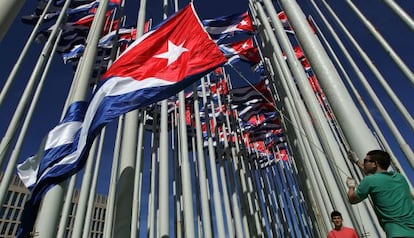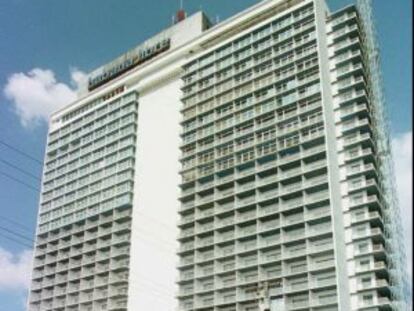Cuba begins releasing 53 political prisoners in compliance with US deal
Releases were part of agreement made before announcement of normalization of relations

While their names have not been made public, the US confirmed on Tuesday that the Cuban government had begun releasing 53 political prisoners as part of the pre-arranged agreement with Washington aimed at normalizing bilateral relations.
Nevertheless, various dissident organizations on the island said they had no information concerning the prisoners.
“They have already released some of the prisoners,” said US State Department spokesman Jen Psaki on Tuesday. “We will continue, of course, to urge the Cuban government to follow through on its commitment. We’d like to see this completed in the near future.”
Psaki said Washington has decided not to release the names of the 53 despite demands for transparency by the families of the prisoners and human rights groups.
We are being careful because we don’t want to put a bigger target on Cuban political dissidents” US State Department spokesman Jen Psaki
“It’s important to note that we’ve been very careful about discussing these prisoners and this process because we’re not looking to put a bigger target on Cuban political dissidents. We’re looking to get them released, and this is the process that we think will be most effective in getting that done,” she said.
The prisoners were part of a deal between Washington and Havana that was hammered out before President Obama announced on December 17 that the United States would begin work to normalize relations with Cuba.
As part of the swap, US contractor Alan Gross, who was imprisoned on the island for five years, returned to the United States on the day of the announcement of normalization of relations, which was made jointly in Washington and Havana. The United States also set free the last three remaining prisoners who made up the so-called Cuban Five, who were convicted of espionage and conspiracy 16 years ago and given prison sentences by a federal judge that ranged from 15 years to life. They were returned to Havana.
Roberta Jacobson, assistant secretary of state for Western Hemisphere Affairs, revealed last week on a PBS broadcast that Sonia Garro, a member of the dissident group Ladies in White, was one of the 53. Garro was released from a Cuban jail cell on December 10. “The Cuban government has said that those people will be released as their own decision,” Robertson said. “There have been others who have been released.”
Many Washington officials worked behind the scenes to come up with the final list of imprisoned dissidents
When asked Tuesday if the White House came up with the list, Psaki, the State Department spokeswoman, explained that it was put together with two National Security Council officials who were involved with the negotiations. “Obviously, there were others through the interagency who were coordinating behind the scenes or discussing behind the scenes, but it’s a process that was put together by the administration.”
The announcement about the release of some dissidents came after Florida Republican US Senator Marc Rubio urged Obama in a letter not to begin talks with Cuban officials scheduled for later this month until all of the prisoners were released.
Jacobson will lead a delegation of top officials to Havana to begin discussions on migration issues. But the State Department’s Psaki confirmed that “we plan on discussing human rights issues directly with the Cuban Government” during the migration and normalization talks.
Tu suscripción se está usando en otro dispositivo
¿Quieres añadir otro usuario a tu suscripción?
Si continúas leyendo en este dispositivo, no se podrá leer en el otro.
FlechaTu suscripción se está usando en otro dispositivo y solo puedes acceder a EL PAÍS desde un dispositivo a la vez.
Si quieres compartir tu cuenta, cambia tu suscripción a la modalidad Premium, así podrás añadir otro usuario. Cada uno accederá con su propia cuenta de email, lo que os permitirá personalizar vuestra experiencia en EL PAÍS.
¿Tienes una suscripción de empresa? Accede aquí para contratar más cuentas.
En el caso de no saber quién está usando tu cuenta, te recomendamos cambiar tu contraseña aquí.
Si decides continuar compartiendo tu cuenta, este mensaje se mostrará en tu dispositivo y en el de la otra persona que está usando tu cuenta de forma indefinida, afectando a tu experiencia de lectura. Puedes consultar aquí los términos y condiciones de la suscripción digital.
More information
Últimas noticias
The complicated life of Francesca Albanese: A rising figure in Italy but barred from every bank by Trump’s sanctions
How Japan is trying to avert ‘digital defeat’
Half of Scotland is in the hands of 420 property owners
Reinhard Genzel, Nobel laureate in physics: ‘One-minute videos will never give you the truth’
Most viewed
- Pablo Escobar’s hippos: A serious environmental problem, 40 years on
- Why we lost the habit of sleeping in two segments and how that changed our sense of time
- Charles Dubouloz, mountaineering star, retires at 36 with a farewell tour inspired by Walter Bonatti
- Reinhard Genzel, Nobel laureate in physics: ‘One-minute videos will never give you the truth’
- The Florida Keys tourist paradise is besieged by immigration agents: ‘We’ve never seen anything like this’










































